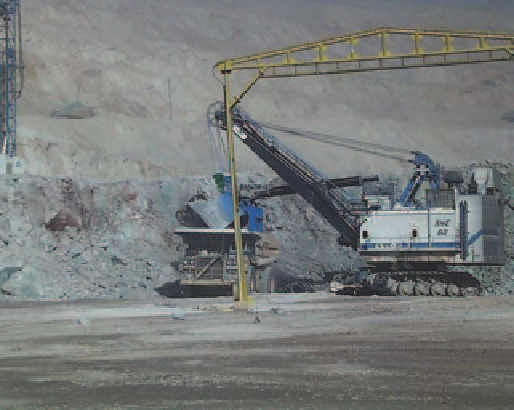Geoscience Reference
In-Depth Information
costs to include in these calculations on a project by project
basis. For example, the company's headquarters corporate
overhead may or may not be included. Each block must be
valued separately considering all of the revenues and costs,
and then blocks with positive total revenue are considered ore.
In what follows “cutoff” implies the economic cutoff de-
scribed by Eq. 7.1 above, unless otherwise defined.
At a very early stage of the project the main concern is
to determine if the deposit contains enough mineralization
to warrant further study and investment, that is, very little
may be known about the potential of the deposit to become
an operating mine. Technical details and specifications for
mine planning and metallurgy are required to estimate ton-
nages and grades delivered to the mill. In this case, since the
proportion of the mineralization that would be recovered is
unknown, it is preferable to estimate “in-situ” resources.
Accounting for mine and mill considerations at the time
of estimating resources is not yet universally accepted. The
sources of dilution and ore loss are well known, but not
easily quantifiable. Some practitioners prefer to calculate
a model of mineralization without engineering constraints.
Dilution then has to be added to the block model by the mine
planning engineer, usually using global factors. In general,
all resource models should be recoverable.
The differentiation between a recoverable
resource
model
and a
reserve
model is based on the wording of the differ-
ent Resource Classification Systems currently in use (see
Sect. 12.3). The term “reserves” is used for material that
has been reasonably proven to be minable with an econom-
ic benefit. This implies that a well-defined mine plan is in
place, that metallurgical studies have proven that the ore is
amenable to beneficiation, that there is a viable market for
the product, and that there are no legal or environmental
impediments for mine development. In addition, a reserve
model may include some additional operational dilution not
explicitly included in the recoverable resource model.
The available drill hole information has a much smaller
volume and scale than mine planning volumes and ore/waste
selection. Drill holes are a few centimeters in diameter, and
each sample typically represents between 10 and 50 kg of ma-
terial. In contrast, a very selective open pit mine would con-
sider mining units of 5 × 5 × 5 m (approximately 325 metric
tons assuming a 2.65 t/m
3
density), while the larger, massive
deposits plan on units that are as large as 25 × 25 × 15 m (ap-
proximately 25,000 metric tons). Some underground mines
can be more selective, but the volume of the planning unit is
still orders of magnitude larger than the drill hole.
The volume of extraction is represented with a “Selective
Mining Unit”, or SMU. The SMU is defined as the small-
est volume that the operation can recover, and depends on
the mining method, the equipment size, the data available at
the time of selection and the selectivity characteristics of the
Fig. 7.1
Bucyrus SME 60 Shovel used at the large tonnage Escondida
Cu Mine, Northern Chile (photo courtesy of BHP Billiton). Benches
are 15 m high
operation. For convenience, it is generally represented as a
rectangular block, even though mines never extract ore and
waste as perfect parallelepipeds.
For open pit mines, the vertical dimension of the SMU is
the bench height, although occasionally some mines operate on
double- or half-bench heights. The lateral dimensions represent
the minimum width of the extraction equipment, with consider-
ation to digging depth, the material's angle of repose, the equip-
ment's maneuverability, and the available information to sup-
port estimates of the grade at short distances. If it is a massive
electric shovel, see Fig.
7.1
, with a nominal loading capacity
of 90,000 tons of material per day, the minimum width will be
about 18-20 m. For such a large operation, the bench height is
usually 15 m, and thus the SMU would be 20 × 20 × 15 m.
If the equipment considered is a front-end loader (such
as the one shown in Fig.
7.2
), the width of the bucket var-
ies between 5.6 and 6.2 m (depending on the model), so it
is generally accepted that the minimum width for selectiv-
ity will be about 8-10 m. Typical bench height is 10 m, so
that a common SMU size for this type of operation could be
10 × 10 × 10 m.
These two examples assume that there would be sufficient
grade control sampling and adequate grade control practices
to estimate reliable values at the SMU scale mentioned. The
SMU size could be bigger with difficult deposits and poor
grade control sampling. The ore and waste may be defined
by a sharp visual contact. In such cases, the equipment may
be able to mine to contacts with only 2 or 3 m of dilution/
lost ore.
Underground mining methods vary widely in selectiv-
ity. They are often more selective than open pits, but there
are significant exceptions, such as mines that use block or

